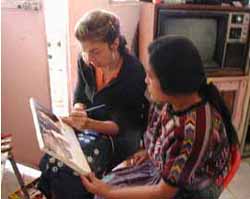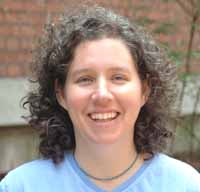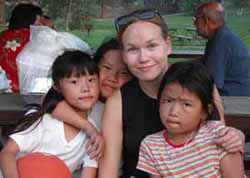The President's Grant for Student Research in Diversity Honorable Mention Recipients
Recently, the Committee for Community and Diversity (CCD) announced the 2003 recipients of The President's Grant for Student Research in Diversity, which provides support for outstanding student research projects related to diversity including culture, language, gender, sexual orientation, race-ethnicity, and disabilities.
The process was extremely competitive because there were twice as many proposals submitted this year. Ultimately, two were selected as grant recipients with a $3,000 award: Hui Soo Chae and John David Connor whose research was discussed in last month's issue of Inside TC. This month, we are highlighting Kryssi Staikidis, Sarah A. Strauss and Terri S. Wilson, who were selected for the honorable mention awards of $1,000.
KRYSSI STAIKIDIS is working with faculty sponsor Graeme Sullivan, Associate Professor of Art Education, on "Looking Toward Tz'utuhil Ways of Knowing-Painting, Pedagogy and Mentorship: A Collaboration Between Artists."
Staikidis, who has taught elementary and high school art classes, is looking at ways of incorporating Mayan ways of knowing into studio art curricula in higher education. To do this, she went to Guatamala to learn from two painters-one male Tz'utuhil painter and one female Kaqchikel painter-who have completely different styles. She chose this particular group of indigenous people because their painting, which only began in the last century, does not include European ways of knowing, teaching or learning.
The study, which uses ethnographic participant-observation, examines the methods of artistic studio practice and pedagogy among painters whose work takes place in a non-formal learning context where artwork is made at the home and surrounding community.
"Art is its own language and has the power to transcend cultures," said Staikidis. "As a cultural outsider, taking lessons with the teachers, the language of art took over. All the painting I did led to a camaraderie that was formed through this language of art that would have taken years to establish otherwise."
SARAH A. STRAUSS is working with faculty sponsor Aaron Pallas, Professor of Sociology and Education, on "Same-Sex Sexual Attraction, Suicidality, and the School Environment: Extending Hirschi's Theory of Social Control."
When Pallas first met Strauss, she expressed an interest in writing a dissertation that could help explain why lesbian and gay teens are more likely to engage in risky behaviors than straight teens. The popular explanation attributing this to the psychological frailties and interior lives of these teens didn't ring true to her, based on what she had seen as a high school teacher and advisor to lesbian and gay student groups, said Pallas.
"Sarah sought an explanation that looked at the connection between the individual and his or her social context. She started with social control theory, a theory of delinquency that emphasizes the presence or absence of social bonds-attachments, commitments, involvements, and beliefs-between individuals and society," said Pallas. Although the notion of the social bond appealed to her, she realized that the social control framework placed the individual in the foreground and the social context in the background. Society's treatment of the individual was taken for granted by the theory. This was a problem, because there's lots of evidence of the stigma of being labeled gay in high school, and social control theory had no place for that.
"Sarah's research is extending social control theory to incorporate individuals' experience of how they are treated by society into the explanation for risky behaviors," he added. "This is very exciting intellectually, but it also has the potential to guide policies that will reduce the risks lesbian and gay youth confront," said Pallas, Professor of Sociology and Education.
Strauss hypothesizes that lesbian, gay and bisexual (LGB) youth suicidality is related to the environments in which they live. Specifically, she proposes that LGB youth suicidality can be understood by using a model utilized to explain delinquency. The dominant theories of delinquency are, however, incomplete. This study seeks to explore the process that results in high rates of LGB youth suicidal thoughts and suicide attempts.
"Gay people don't just emerge after high school, they exist way before that, and we're not taking care of them," said Strauss. "We need to understand them to take care of their needs. That could save some kids and make high school a happier place for them."
TERRI S. WILSON is working with faculty sponsor David Hansen, Professor of Philosophy and Education, on "The Jane Addams School for Democracy: A Case Study of How Teachers and Immigrant Parents Conceptualize their Work to Build School-Community Partnerships."
"Terri is bringing together educational theory and practice, looking through an philosophical lens," said Hansen. "She is trying to understand and expand the human experience. This study is really at the conjunction of what philosophy and education really is. It's Deweyian in the best spirit of the word-connecting people of the community with the community of the school and finding a creative way to bring these communities into juxtaposition."
This research project investigates a particular school-community partnership between the Jane Addams School for Democracy, a grassroots popular education initiative involving immigrant families, and the public schools within its surrounding community.
"Jane Addams isn't in an actual school building it's located in a community center. It's a neighborhood learning community that makes learning and pathways between communities visible and traveled. It encourages collaboration," said Wilson.
In particular, Wilson examines how teachers and parents employ a family of concepts (school, community, teacher, learner, involvement) to meet similar and collaborative aims. She investigates the language used by parents and teachers to describe shared community-building work, the ways this language differs (and doesn't) across groups and cultures, and how both groups assign different meanings to the same concepts.
"We need to involve teachers as a powerful constituent, who share many of the same concerns as parents, about how we think of schools and how they are structured," said Wilson.
The CCD Grant Review Committee included Christy Bagwell, John Broughton, Katherine Cuevas, Yvonne Destin, Celia Genishi, Richard Keller, Mark Noizumi, Sophia Pertuz, Barbara Purnell, Janice S. Robinson, Michael T. Spratt and Marianne Tramelli.
Published Monday, Oct. 6, 2003


